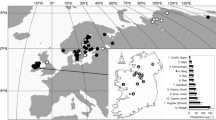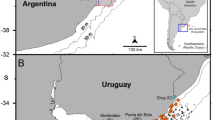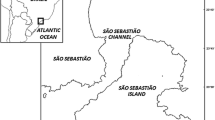Abstract
Although mysids play important roles in marine food chains, studies on their production are scarce, especially for warm-water species. We investigated life history and production of Orientomysis robusta in a shallow warm-temperate habitat of the Sea of Japan. Its spawning and recruitment occurred throughout the year; 19 overlapping cohorts were recognizable over an annual cycle. The summer cohorts recruited in July–September exhibited rapid growth, early maturity, small brood size, and small body size. A converse set of life history traits characterized the autumn–winter cohorts recruited in October–March. The spring cohorts recruited in April–June had intermediate characteristics of both cohorts. Life spans were 19–33, 21–48, and 69–138 days for summer, spring, and autumn–winter cohorts, respectively, and mortality rates were high for spring and summer cohorts, especially during June–August but were low for autumn–winter cohorts. Production calculated from the summation of growth increments was 488.8 mg DW m−2 year−1 with an annual P/B ratio of 21.26. The short life span seems to be responsible for such an extremely high P/B ratio. A method not requiring recognition and tracking cohorts gave similar values (534.0 mg DW m−2 year−1 and 20.49). The close agreement in production values between the two methods indicates our estimates are valid.









Similar content being viewed by others
References
Akamine T (1985) Consideration of the BASIC programs to analyze the polymodal frequency distribution into normal distributions (in Japanese with English abstract). Bull Jpn Sea Reg Fish Res Lab 35:129–159
Astthorsson OS, Ralph R (1984) Growth and moulting of Neomysis integer (Crustacea: Mysidacea). Mar Biol 79:55–61
Azeiteiro UMM, Jesus L, Marques JC (1999) Distribution, population dynamics, and production of the suprabenthic mysid Mesopodopsis slabberi in the Mondego Estuary, Portugal. J Crust Biol 19:498–509
Begon M, Harper JL, Townsend CR (1990) Ecology: individuals, populations, and communities, 2nd edn. Blackwell, Cambridge
Benke AC (1979) A modification of the Hynes method for estimating secondary production with particular significance for multivoltine populations. Limnol Oceanogr 24:168–171
Brey T (2001) Population dynamics in benthic invertebrates. A virtual handbook, Ver 01.2. http://www.thomas-brey.de/science/virtualhandbook. Accessed 9 June 2010
Carrasco FD, Arcos DF (1984) Life history and production of a cold-temperate population of the sublittoral amphipod Ampelisca araucana. Mar Ecol Prog Ser 14:245–252
Cartes JE, Sorbe JC (1999) Estimating secondary production in bathyal suprabenthic peracarid crustaceans from the Catalan Sea slope (western Mediterranean; 391–1255 m). J Exp Mar Biol Ecol 239:195–210
Cartes JE, Elizalde M, Sorbe JC (2001) Contrasting life-histories, secondary production, and trophic structure of Peracarid assemblages of the bathyal suprabenthos from the Bay of Biscay (NE Atlantic) and the Catalan Sea (NW Mediterranean). Deep-Sea Res I 48:2209–2232
Cartes JE, Brey T, Sorbe JC, Maynou F (2002) Comparing production-biomass ratios of benthos and suprabenthos in macrofaunal marine crustaceans. Can J Fish Aquat Sci 59:1616–1625
Collie JS (1985) Life history and production of three amphipod species on Georges Bank. Mar Ecol Prog Ser 22:229–238
Cooper KL, Hyatt KD, Rankin DP (1992) Life history and production of Neomysis mercedis in two British Columbia coastal lakes. Hydrobiologia 230:9–30
Crisp DJ (1984) Energy flow measurements. In: Holm NA, McIntyre AD (eds) Methods for the study of marine benthos, 2nd edn. IBP Handbook, no 16. Blackwell, Oxford, pp 284–372
Dauvin J-C (1988) Life cycle, dynamics and productivity of Crustacea-Amphipoda from the western English Cannel. 4. Ampelisca armoricana Bellan-Santini et Dauvin. J Exp Mar Biol Ecol 123:235–252
Dauvin J-C (1989) Life cycle, dynamics and productivity of Crustacea-Amphipoda from the western English Cannel. 5. Ampelisca sarsi Chevreux. J Exp Mar Biol Ecol 128:31–56
Fenton GE (1994) Breeding biology of Tenagomysis tasmaniae Fenton, Anisomysis mixta australis (Zimmer) and Paramesopodopsis rufa Fenton from south-eastern Tasmania (Crustacea: Mysidacea). Hydrobiologia 287:259–276
Fenton GE (1996) Production and biomass of Tenagomysis tasmaniae Fenton, Anisomysis mixta australis (Zimmer) and Paramesopodopsis rufa Fenton from south-eastern Tasmania (Crustacea: Mysidacea). Hydrobiologia 323:23–30
Fujii T, Noguchi M (1996) Feeding and growth of Japanese flounder (Paralichthys olivaceus) in the nursery ground. In: Watanabe Y, Yamashita Y, Oozeki Y (eds) Survival strategies in early life stages of marine resources. A. A. Balkema, Rotterdam, pp 141–151
Fukuoka K, Murano M (2005) A revision of East Asian Acanthomysis (Crustacea: Mysida: Mysidae) and redefinition of Orientomysis, with description of a new species. J Natl Hist 39:657–708
Hamilton AL (1969) On estimating annual production. Limnol Oceanogr 14:771–782
Hanamura Y (1999) Seasonal abundance and life cycle of Archaeomysis articulata (Crustacea: Mysidacea) on a sandy beach of western Hokkaido, Japan. J Natl Hist 33:1811–1830
Hirota Y (1990) Seasonal changes in the density of mysids and their size eaten by juvenile Japanese flounder Paralichthys olivaceus in Igarashi-hama, Niigata (in Japanese). Contrib Fish Res Jpn Sea Block 19:73–88
Hirota Y, Koshiishi Y, Naganuma N (1990) Size of mysids eaten by juvenile Japanese flounder Paralichthys olivaceus and diurnal change of its feeding activity (in Japanese with English abstract). Nippon Suisan Gakkaishi 56:201–206
Hirota Y, Tominaga O, Kamiharako T, Kodama K, Sadakata T, Tanaka M, Furuta S, Kojima K, Koshiishi Y (1989) Geographical distribution of mysids in shallow waters of the Japan Sea (in Japanese). Contrib Fish Res Jpn Sea Block 15:43–57
Hynes HBN, Coleman MJ (1968) A simple method of assessing the annual production of stream benthos. Limnol Oceanogr 13:569–573
Ii N (1964) Fauna Japonica, Mysidae (Crustacea). Biogeographical Society of Japan, Tokyo
Itô Y (1975) Animal ecology, vol 1 (in Japanese). Kokin-shoin, Tokyo
Johnston NT, Northcote TG (1989) Life-history variation in Neomysis mercedis Holmes (Crustacea: Mysidacea) in the Fraser River estuary, British Columbia. Can J Zool 67:363–372
Kanneworf E (1965) Life cycle, food and growth of the amphipod Ampelisca macrocephala Liljeborg from the Oresund. Ophelia 2:305–318
Lejeusne C, Chevaldonné P (2005) Population structure and life history of Hemimysis margalefi (Crustacea: Mysidacea), a ‘thermophilic’ cave-dwelling species benefiting from the warming of the NW Mediterranean. Mar Ecol Prog Ser 287:189–199
Mauchline J (1980) The biology of mysids. In: Blaxter JHS, Russell FS, Yonge M (eds) Advances in marine biology, vol 18. Academic Press, New York, pp 1–369
McKenney CL Jr (1996) The combined effects of salinity and temperature on various aspects of the reproductive biology of the estuarine mysid, Mysidopsis bahia. Invertebr Reprod Dev 29:9–18
Mees J, Abdulkerim Z, Hamerlynck O (1994) Life history, growth and production of Neomysis integer in the Westerschelde estuary (SW Netherlands). Mar Ecol Prog Ser 109:43–57
Moore PG (1981) The life histories of the amphipods Lembos websteri Bate and Corophium bonnellii Milne Edwards in kelp holdfasts. J Exp Mar Biol Ecol 49:1–50
Morgan MD (1985) Growth and its relationship to reproduction in Mysis relicta. In: Wenner AM (ed) Factors in adult growth, Crustacean Issues 3. Balkema, Rotterdam, pp 235–250
Morin A, Bourassa N (1992) Modèles empiriques de la production annuelle et du rapport P/B d’invertébrés benthiques d’eau courante. Can J Fish Aquat Sci 49:532–539
Murano M (1964) Fisheries biology of a marine relict mysid Neomysis intermedia Czerniawsky. III. Lifecycle, with special reference to the reproduction of the mysid (in Japanese). Suisanzoushoku 12:19–30
Murano M (1984) Two new species of Acanthomysis (Crustacea, Mysidacea) from Japan. Bull Natl Sci Mus Tokyo, Ser A Zool 10:107–116
Okumura T (2003) Relationship of ovarian and marsupial development to the female molt cycle in Acanthomysis robusta (Crustacea: Mysida). Fish Sci 69:995–1000
Pezzack DS, Corey S (1979) The life history and distribution of Neomysis americana (Smith) (Crustacea: Mysidacea) in Passamaquoddy Bay. Can J Zool 57:785–793
Plante C, Downing JA (1989) Production of freshwater invertebrate populations in lakes. Can J Fish Aquat Sci 46:1489–1498
Richoux NB, Deibel D, Thompson RJ (2004) Population biology of hyperbenthic crustaceans in a cold water environment (Conception Bay, Newfoundland). I. Mysis mixta (Mysidacea). Mar Biol 144:881–894
Robertson AI (1979) The relationship between annual production: biomass ratios and lifespans for marine macrobenthos. Oecologia 38:193–202
Sainte-Marie B (1991) A review of the reproductive bionomics of aquatic gammaridean amphipods: variation of life history traits with latitude, depth, salinity and superfamily. Hydrobiologia 223:189–227
Schlacher TA, Wooldridge TH (1996) Patterns of selective predation by juvenile, benthivorous fish on estuarine macrofauna. Mar Biol 125:241–247
Sell DW (1982) Size-frequency estimates of secondary production by Mysis relicta in Lakes Michigan and Huron. Hydrobiologia 93:69–78
Slattery PN (1985) Life histories of infaunal amphipods from subtidal sands of Monterey Bay, California. J Crust Biol 5:635–649
Sudo H (2003) Effect of temperature on growth, sexual maturity and reproduction of Acanthomysis robusta (Crustacea: Mysidacea) reared in the laboratory. Mar Biol 143:1095–1107
Sudo H (2005) Production of benthic preys for juvenile fishes (in Japanese). In: Hayashi I, Nakao S (eds) Benthos in fisheries science. Koseisha-Koseikaku, Tokyo, pp 49–61
Sudo H, Azeta M (1992) Selective predation on mature male Byblis japonicus (Amphipoda: Gammaridea) by the barface cardinalfish, Apogon semilineatus. Mar Biol 114:211–217
Sudo H, Azeta M (1996) Life history and production of the amphipod Byblis japonicus Dahl (Gammaridea: Ampeliscidae) in a warm temperate zone habitat, Shijiki Bay, Japan. J Exp Mar Biol Ecol 198:203–222
Toda H, Takahashi M, Ichiura S (1984) The effect of temperature on the post-embryonic growth of Neomysis intermedia Czerniawsky (Crustacea, Mysidacea) under laboratory conditions. J Plankton Res 6:647–662
Tumbiolo MT, Downing JA (1994) An empirical model for the prediction of secondary production in marine benthic invertebrate populations. Mar Ecol Prog Ser 114:165–174
Vicente CS, Sorbe JC (1995) Biology of the suprabenthic mysid Schistomysis spiritus (Norman, 1860) in the southeastern part of the Bay of Biscay. Sci Mar 59(Suppl 1):71–86
Weltzien F-A, Planas M, Fyhn HJ (1999) Temperature dependency of early growth of turbot (Scophthalmus maximus L.) and its implications for developmental progress. J Exp Mar Biol Ecol 242:201–210
Wooldridge TH (1986) Distribution, population dynamics and estimates of production for the estuarine mysid, Rhopalophthalmus terranatalis. Est Coast Shelf Sci 23:205–223
Yamada K, Takahashi K, Vallet C, Taguchi S, Toda T (2007) Distribution, life history, and production of three species of Neomysis in Akkeshi-ko estuary, northern Japan. Mar Biol 150:905–917
Yamada H, Yamashita Y (2000) Effect of temperature on intermolt period, growth rate and reproduction rate in Acanthomysis mitsukurii (Crustacea, Mysidacea). Crustac Res 29:160–169
Yoshida N, Takatsu T, Nakaya M, Joh M, Kimura O, Shimizu S (2005) Catch efficiencies of the Hirota’s sledge net for crangonid shrimp and juvenile marbled sole (in Japanese with English abstract). Nippon Suisan Gakkaishi 71:172–177
Acknowledgments
We thank T. Fujii for his assistance in the field collections; N. Naganuma for her assistance in sorting the samples; M. Nakagawa for his help in computer analysis; and Y Hirota for his valuable discussion. This work was supported in part by a grant (BCP) from the Ministry of Agriculture, Forestry and Fisheries. This is contribution no. 11011301 from National Research Institute of Fisheries and Environment of Inland Sea.
Author information
Authors and Affiliations
Corresponding author
Additional information
Communicated by X. Irigoien.
Rights and permissions
About this article
Cite this article
Sudo, H., Kajihara, N. & Noguchi, M. Life history and production of the mysid Orientomysis robusta: high P/B ratio in a shallow warm-temperate habitat of the Sea of Japan. Mar Biol 158, 1537–1549 (2011). https://doi.org/10.1007/s00227-011-1669-8
Received:
Accepted:
Published:
Issue Date:
DOI: https://doi.org/10.1007/s00227-011-1669-8




